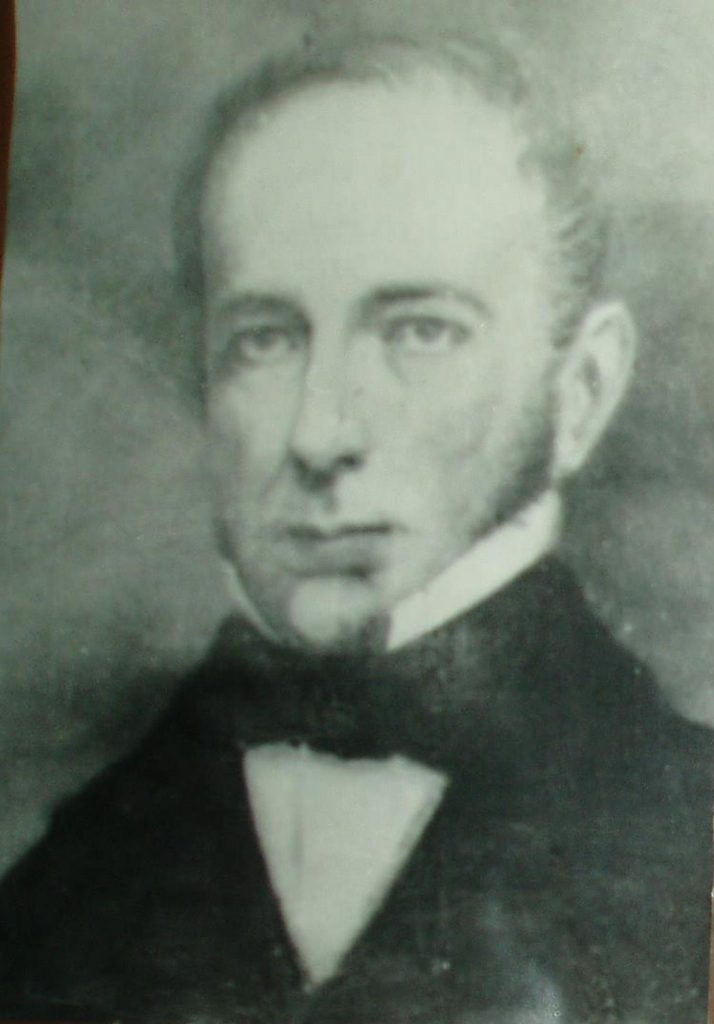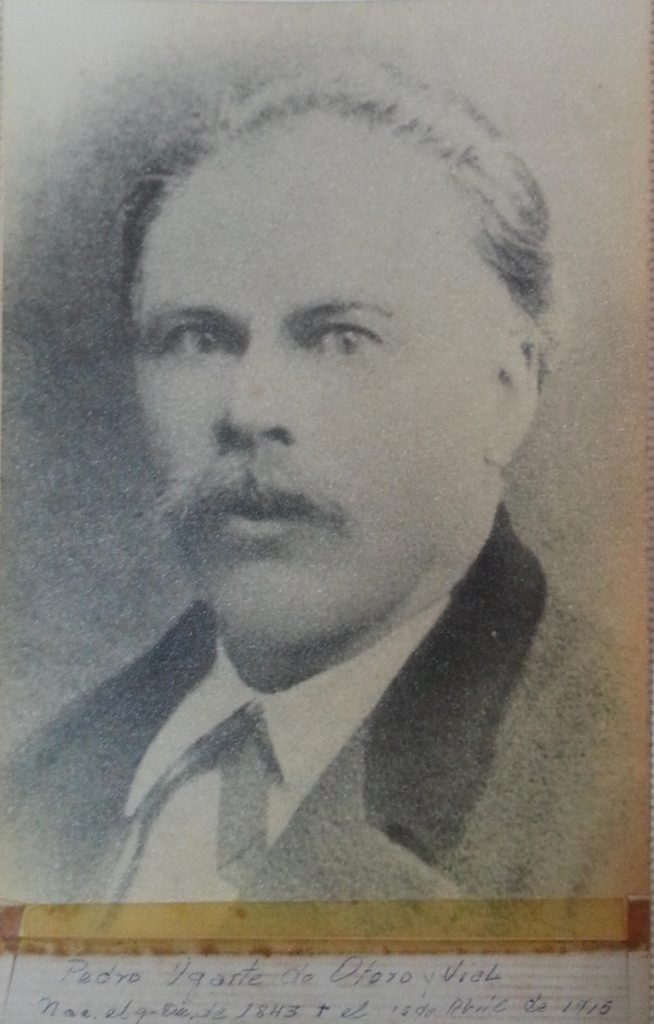Judge Pedro Ugarte Ramírez (1817-1867)
Curiosity + Chance = This story.
As children we admired with a mixture of respect and curiosity the six photo-portraits hanging in the corridor of the Fundo La Paz, in the heights of Angol, Chile.
We recognized the first one, the famous ¨Contador Ugarte¨ and the last two, of ¨Tata Arturo”, my maternal grandfather, and his son, my dear Tío Vicho, pioneer of our family history. The three serious and elegant gentlemen in the middle were a mystery.
Thirty years later, they were hanging in the Hacienda Tipay in Caimanes in Chile´s near North. Their formal frames had disappeared and beneath the photos there were names, dates and handwritten notes. These clues, purposefully left by my uncle Vicho, piqued my curiosity.
The key clue comes from 2001. During an interview recorded in Montevideo by Uruguayan singer-songwriter Daniel Viglietti, our dear Tía Tola Ugarte, proudly mentions Judge Pedro Ugarte. From there it went downhill.
We found a typed copy at Harvard of the original 1879 book, which we quote below In Chile in 2017, a friend who is an avid reader, showed med me the original book whose first page is this photo-engraving of Judge Pedro Ugarte.

Family Origins
Pedro Ugarte Ramírez, PUR, was born in 1817, seven years after Chile obtained its Independence from Spain. During his childhood and until 1823, supporters of the young Chilean nation faced royalist troops and supporters in several battles until Spain finally recognized its independence in 1844.
His father, like his grandfather, was Mayor of Santiago, Secretary of Government and Member of His Majesty’s Council. PUR was the twelfth of thirteen children and the only surviving male from the marriage of José Santiago Ugarte Salinas (1759-1812) with María Mercedes Ramírez de Saldaña Velasco,the daughter of a wealthy merchant.

As of March 2023, our only source of personal information about PUR is the book by his friend and liberal co-religionist, the historian Benjamín Vicuña Mackenna. Quotes from hiswork, are in italics.
A partial collection of excerpts from this work, linked to PUR, can be seen here.
Youth, Studies and Offspring.
According to Vicuña Mackenna, PUR ¨was raised spoiled, haughty and ostentatious, and spent the first years of his youth in the leisure of ardent and easy pleasures¨ until¨he reacted and entered the path of duty and study.¨.
PUR graduated as a lawyer at the age of 22 in 1839, after having had as a professor of Law – by one of those ironies of fate – Manuel Montt, the future minister, elected president of Chile in September, 1851. ¨But law was neither an occupation nor a resource for Ugarte: it was only a social symbol; and he madly committed the last assets of his estate in one of the great ¨tertulias¨ or regular evening social gatherings of that time¨
In 1843, at the age of 26, with Carmen de Otero, he fathered Pedro Ugarte Otero (1843-1914). His name is handwritten as ¨Pedro Ugarte de Otero y Vial¨ below his adult portrait.

The closeness to the Vial family, observed during our childhood, is explained when we read that PUR had ¨great personal affection for the Vial family ¨. PUR legally recognized his son Pedro, but the child was raised by an older sister, Rafaela Ugarte Ramírez, married to Jacobo Vial Formas, from a large and influential family of ministers, deputies and merchants.
The origins and destiny of Carmen de Otero are still an enigma to be solved. ¨Carmen Otero¨ appears on the official death certificate of her son, issued in 1914 at the La Victoria Estate in Trebulco, near Talagante, Chile. Any information about Carmen Otero and her descendants would be most welcome.
In August 1844, PUR married Natalia del Solar Valdés. According to the wonderful Genealogía Ugarte por Mauricio Pilleux, they had three children, including a priest and a nun, but no known offspring.
Judge Ugarte and the beating of the ¨Sociedad de la Igualdad¨ (Equality Society).
Through family influence, rather than by vocation, PUR entered the judiciary. “Certain in his judgments, firm in his moral convictions, inexorable against crime and criminals, he made a truly popular name for himself with his actions and hard work. In 1850, Judge Ugarte was, the terror of the wicked.”
“Unfortunately, he imprudently jeopardized the jurisprudence position he held, when his supporters led him to the Council in the elections of 1849. He was immediately elected mayor and was the soul of that body, in which unrest took hold from the very first hour”.
Towards the end of 1849, the Club de La Reforma was created in Santiago to spread democratic ideas and support the Liberal deputies and press in opposition to the Conservative government. In April 1850, upon Francisco Bilbao and Santiago Arcos’ return from their studies in Europe, they fervently imposed their ideas, brought from France, of Liberty, Equality and Fraternity. The Sociedad de la Igualdad, SI, was born.
The SI, in order to improve the working class, gives classes to its artisan members and proposes projects for free public education and public baths. These meet with open and strong opposition from the Conservative party and its presidential candidate, the Minister of the Interior, Manuel Montt.
On the night of August 19, 1850, at the end of a meeting of the SI, the government sent a group of thugs and police to beat up the directors. Several people were seriously injured, including the liberal deputy Rafael Vial Formas, brother-in-law of Judge Ugarte. ‘Warned by the Vial family, the Judge of Santiago’s Criminal Court took quick action and that same night arrested and began a summary against the detainees.
The government exerted pressure to make public the normally secret summary and to hinder the legal case. When Judge Ugarte rejected this pressure, the government succeeded in having Judge Ugarte suspended by the High Court on September 6,1850.
Following growing regional protests against the authoritarian excesses of the government, on November 7, 1850, it declared a state of siege in the provinces of Santiago and Aconcagua and ordered the arrest of Judge Pedro Ugarte and the entire leadership of the SI, including some opposition politicians.
Ugarte, Bilbao, Vicuña and several others managed to escape and begin plotting an armed revolution. During this period Judge Ugarte assumes leadership and is nicknamed by his co-conspirators ¨the apostle of those in hiding¨.
The Events of April 20, 1851.
Very early that Monday, began in Santiago the military uprising that Ugarte and his fellow revolutionaries had entrusted to a military leader they trusted. Ugarte had to stay in the Plaza to prevent the escape of a hundred prisoners from the jail, on his own and armed only with his cane and pistol.
By mid-morning, the indecisions and lack of leadership of the designated military leader forced Ugarte to relieve him of command on the street, in front of his troops. But it was too late. The brave and daring President, Army General Manuel Bulnes, led the government forces on the street and sealed the defeat of the uprising. The events of the day cost 27 dead and 87 wounded to the government troops and was the prelude to the Revolution of late 1851.
Exile to Peru.
PUR and José Miguel Carrera escaped at night in a horse-drawn cart towards Maule, posing as cattle buyers, but were arrested in San Fernando and, together with Vicuña, imprisoned in the Cuartel de Granaderos. Francisco Bilbao left for Peru disguised as a cleric, never to return to his homeland.
PUR was exiled by the government to England. During the voyage, Ugarte persuaded the ship’s captain to leave him in Callao, Peru. He served his exile in Lima and for years PUR maintained an active exchange of letters with his friends, as can be seen in Domingo Santa María’s essay about the Revolution of 1851.
His return to Chile.
We do not know the exact date of PUR’s return to Chile or his activities. He was elected deputy for Talca in 1867 but died a few months before taking office, at the age of fifty.
The anecdotal family note under his photo indicates: “He died poisoned by order of President Manuel Montt in 1851¨ This date of his death is incorrect. Without further evidence in this regard, it is interesting to note that in 1851 Judge Ugarte suffered from severe stomach cramps and that on April 20, “ Suffering from his cruel illness, Ugarte had taken up residence in the Vazquez pharmacy where he consumed one after another potions of liquid rubber as sedatives for his illness and for his boiling bile.”
We would appreciate information about his exile in Lima, his return to Chile and about his son Pedro Ugarte Otero and his wife, Gertrudis Castro.
VMU, March 31, 2023.